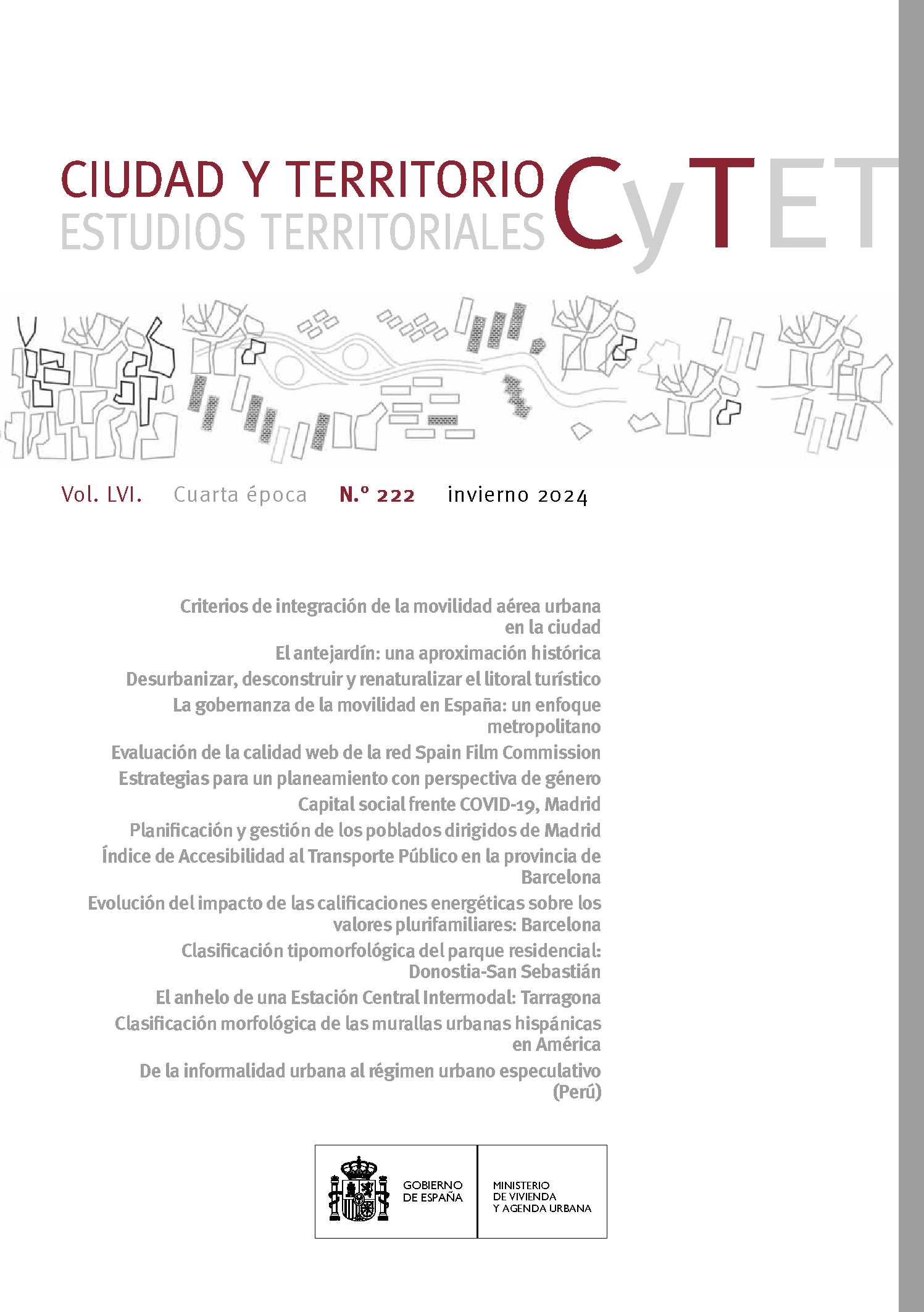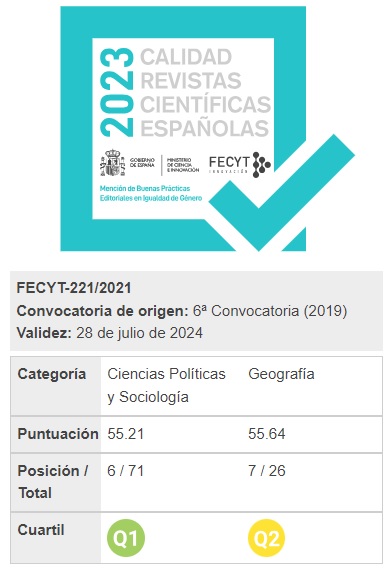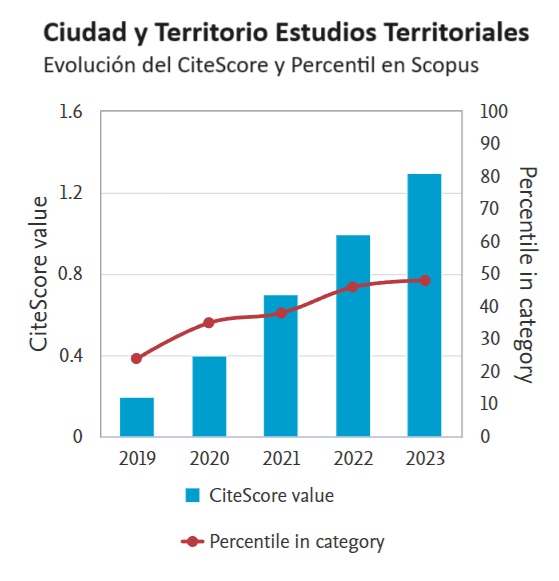Cinema as a territory promoter: contributions of the Spain Film Commission network to the Spain Country Brand
DOI:
https://doi.org/10.37230/CyTET.2024.222.5Keywords:
Marca España, Territorial Brand, Film Commission, Spanish Cinema, Web Quality IndexAbstract
This paper studies the image of Spain and its communication from the web pages of the Spanish film commissions. After reviewing the literature, six experts from different Spanish entities are interviewed to extract several keys that shape the value proposition of Spain: “Spanish personalities”, “Spanish talent”, “locations”, “diversity”, “economic factor” and “relationship with other film commissions”. These keys are included in a consolidated web analysis matrix, which is adapted for the case of analysis of the web pages of the Spanish film commissions network. Results show that, despite the advantages offered by the cultural sector when it comes to promoting perceptions about territories (and their commercial development), these institutions do not sufficiently exploit the national value proposition in terms of developed content, noting lower use of the value proposition of Spain as a brand.
Downloads
References
AAKER, D. & ÁLVAREZ, R. (2014): Las marcas según Aaker. 20 principios para conseguir el éxito. Barcelona, España, Empresa Activa.
ABÓ, J.I. (2001): Un modelo conceptual para generar una Marca País. Revista de Antiguos Alumnos del IEEM, Año 4(2), pp. 24-34. https://dialnet.unirioja.es/servlet/articulo?codigo=2753424
ALADWANI, A. & PALVIA, P. (2002): Developing and validating an instrument for measuring user-perceived web quality. Information & management, 39(6), pp. 467-476. https://doi.org/10.1016/S0378-7206(01)00113-6
ANHOLT, S. (2003): Brand New Justice. Londres, Reino Unido, Butterworth-Heinemann.
ANHOLT, S. (2007): Competitive Identity: The New Brand Management for Nations, Cities and Regions. Londres, Reino Unido, Palgrave Macmillan. https://doi.org/10.1057/9780230627727
ANUSHA, R. (2014): A study on website quality models. International journal of scientific and research publications, 4(12). https://www.ijsrp.org/research-paper-0115/ijsrp-p3768.pdf
ARAÚJO, N. (2015): De la economía de experiencias al turismo experiencial. Las series de ficción como creadoras de experiencias e inductoras a la visita de destinos turísticos. PASOS Revista de Turismo y Patrimonio Cultural, 13(4), pp. 959-964. https://doi.org/10.25145/j.pasos.2015.13.065
ARAÚJO, N. & DOMÍNGUEZ, T. (2012): Los festivales de cine como elemento potenciador de destinos turísticos. El caso de San Sebastián. Vivat Academia. Revista De Comunicación, 121, pp. 31-49. https://doi.org/10.15178/va.2012.121.31-49
ARAÚJO, N. & FRÁIZ, J.A. (2013): Las series audiovisuales como herramienta promocional de un destino turístico: el caso de España. Investigaciones Europeas de Dirección y Economía de la Empresa, 19(1), pp. 8-15. https://doi.org/10.1016/j.iedee.2012.07.001
ARAÚJO, N. & FRAIZ, J.A. & DE CARLOS, P. (2021): Film tourism in Spain: Destination awareness and visit motivation as determinants to visit places seen in TV series. European Research on Management and Business Economics, 27(1), pp. 1-11. https://doi.org/10.1016/j.iedeen.2020.100135
ARONCZYK, M. (2013): Branding the Nation: The Global Business of National Identity. Oxford University Press (online edn). https://doi.org/10.1093/acprof:oso/9780199752164.001.0001
ASOCIACIÓN DE DIRECTIVOS DE COMUNICACIÓN & FORO DE MARCAS RENOMBRADAS ESPAÑOLAS & INSTITUTO ESPAÑOL DE COMERCIO EXTERIOR, & REAL INSTITUTO ELCANO DE ESTUDIOS INTERNACIONALES Y ESTRATÉGICOS (eds.) (2003): Informe Proyecto Marca España. http://www.realinstitutoelcano.org/wps/wcm/connect/b9f4f0804f0195c7887cec3170baead1/Informe_Proyecto_Marca_Espana.pdf
Association of Film Commissioners International, AFCI (2020a): Home. Association of Film Commissioners International. https://afci.org/
Association of Film Commissioners International, AFCI (2020b): About AFCI. https://afci.org/about-afci/#about-us
BELLOSO, J.C. (2010): La marca de país. Un mecanisme de diferenciació i font d’intangibles. Paradigmes, 6(5), pp. 43-51.
https://www.raco.cat/index.php/Paradigmes/article/view/218443
BENAVIDES, J. (2010): Qué pasa en España con las marcas y la publicidad en el ámbito de la comunicación institucional. Revista Icono 14, 8(2), pp. 72-89. https://doi.org/10.7195/ri14.v8i2.247
BERNAYS, E. (2010): Propaganda. Santa Cruz de Tenerife, España, Melusina.
CARCAVILLA, F. & ZUGASTI, R. (2019): El vínculo entre la marca España y la cultura en la prensa diaria. AdComunica. Revista Científica de Estrategias, Tendencias e Innovación en Comunicación, 18, pp. 271-296. http://dx.doi.org/10.6035/2174-0992.2019.18.13
CLEMENTE, J. (2015): Presencia de la industria audiovisual española en Internet. En J. CLEMENTE & L. DELTELL & R. GÓMEZ & C. MANZANO & F. PERALES & M. REYES & E. GARCÍA. (eds.). Marca e identidad del cine español. Proyección nacional e internacional entre 1980 y 2014, pp. 495-528. Madrid, España, Fragua.
CLEMENTE, J. & GARCÍA, E. (2016): Contribución de los sitios web de la industria cinematográfica española a la percepción del Cine Español. ZER: Revista de Estudios de Comunicación, 21(40), pp. 67-83. https://doi.org/10.1387/zer.16410
COLBERT, F. & CUADRADO, M. & NANTEL, J. & BILODEAU, S. & RICH, D. & MONTORO, J. (2003): Marketing de las Artes y la Cultura. Barcelona, España, Ariel.
CORBACHO, J.M. & VALDERRAMA, M. & GARCÍA, S. (2014): La imagen de la Marca España en las redes a través de su campaña «I need Spain». Historia y Comunicación Social, 19, pp. 501-512. https://doi.org/10.5209/rev_HICS.2014.v19.44980
EGUSKIZA SESUMAGA, L. & GASTACA EGUSQUIZA, I. (2020): De San Juan de Gaztelugatxe a Rocadragón: el turismo cinematográfico y la implicación de Euskadi en la narración televisiva de Juego de tronos. L'Atalante. Revista de estudios cinematográficos, (30), pp. 89-108. http://www.revistaatalante.com/index.php?journal=atalante&page=article&op=view&path%5B%5D=807
Federación de cines de España, FECE (s.f.): Impacto económico de la exhibición cinematográfica. https://www.fece.com/el-sector/
FERNÁNDEZ NÚÑEZ, L. (2006): ¿Cómo analizar datos cualitativos? Butlletí La Recerca. https://ebevidencia.com/wp-content/uploads/2014/12/analisis-datos-cualitativos.pdf
FERNÁNDEZ CAVIA, J. & DÍAZ LUQUE, P. & HUERTAS, A. & ROVIRA, C. & PEDRAZA JIMÉNEZ, R. & SICILIA, M. & GÓMEZ, L. & MÍGUEZ, M.I. (2013a): Marcas de destino y evaluación de sitios web: una metodología de investigación. Revista Latina de Comunicación Social, 68, pp. 622-638. https://repositori.upf.edu/handle/10230/33631
FERNÁNDEZ CAVIA, J. & VINYALS, S. & LÓPEZ, M. (2013b): Calidad de los sitios web turísticos oficiales de las comunidades autónomas españolas. BiD: textos universitaris de biblioteconomia i documentació, 31. https://doi.org/10.1344/BiD2014.31.7
FRANCESCUTTI, L.P. (2019): Cine y representaciones nacionales: la imagen de España en la ficción internacional. Universitas Humanística, 87, pp. 87-119. https://doi.org/10.11144/Javeriana.uh87.crni
GÁMIR, A. (2013): Produciendo lugares: industria cinematográfica e imaginario social. Anales de geografía, 33(1), pp. 33-61. https://doi.org/10.5209/rev_AGUC.2013.v33.n1.42220
GÁMIR, A. (2016): Geografía y cine. La representación del espacio geográfico en las películas de producción occidental. Valencia, España, Tirant lo Blanch.
GÁMIR, A. & VALDÉS, C.M. (2007): Cine y geografía: espacio geográfic, paisaje y territorio en las producciones cinematográficas. Boletín de la A.G.E., (45), pp. 157-190. https://bage.age-geografia.es/ojs/index.php/bage/article/view/643
GÁMIR, A. & MONTECINO, P. & REYES, S. (2022): Spanish cities as filming locations: analysis and spatial distribution. Boletín de la Asociación de Geógrafos Españoles, (95). https://doi.org/10.21138/bage.3309
GARCÍA, E. & REYES, M. & CLEMENTE, J. (2014): Público y cine en España. Problemas de identidad y marca para un cine propio. Estudios sobre el Mensaje Periodístico, 20(2), pp. 695-718. http://dx.doi.org/10.5209/rev_ESMP.2014.v20.n2.47029
GIRONA, R. (2015): El cine de propaganda en EE.UU. Barcelona, España Editorial UOC.
GÓMEZ, F.J. & MARÍN, J. & PÉREZ, J.P. (2009): El auge del cine autonómico: el caso andaluz. En M. PERLADO & C. JIMÉNEZ (eds.). Escenario actual de la investigación en comunicación: objetivos, métodos y desafíos pp. 183-193. Madrid, España, Actas XI Foro Universitario de Investigación en Comunicación.
GONZÁLEZ BENGOECHEA, A. (2021): La construcción de la Marca España a través de las redes sociales: el caso del Alto Comisionado para la Marca España en Facebook, Twitter y YouTube. [Tesis doctoral, Universidad Complutense de Madrid]. https://docta.ucm.es/entities/publication/ba8f4b95-a23f-403d-b1ff-820c78890fb5
GONZÁLEZ, Ó. & BAÑEGIL, T. & BUENADICHA, M. (2013): El índice cuantitativo de calidad web como instrumento objetivo de medición de la calidad de sitios web corporativos. Investigaciones Europeas de Dirección y Economía de la Empresa, 19(1), pp. 16-30. https://doi.org/10.1016/j.iedee.2012.07.004
GONZÁLEZ, D. & NIETO, J. (2013): Acción de las comisiones fílmicas, la experiencia de Santiago de Compostela Film Commission. Razón y Palabra, 85. https://www.redalyc.org/articulo.oa?id=199531506018
GUPTA, S. & FOROUDI, M. & VÄÄTÄNEN, J. & GUPTA, S. & WRIGHT, L.T. (2020): Nations as brands: Cinema's place in the branding role. Journal of Business Research, 116, pp. 721-733. https://doi.org/10.1016/j.jbusres.2018.02.017
HASAN, L. & ABUELRUB, E. (2011): Assessing the quality of web sites. Applied computing and informatics, 9(1), pp. 11-29. https://doi.org/10.1016/j.aci.2009.03.001
HEREDERO, O. & REYES, F. (2017): Presente y futuro de las ayudas a la industria cinematográfica española. Fotocinema: revista científica de cine y fotografía, 14, pp. 341-363. https://doi.org/10.24310/Fotocinema.2017.v0i14.3604
HERNÁNDEZ HERRERA, M. & GIL RUIZ, F.J. & GARCÍA, M.L. & AYESTARÁN, R. (2020): Marketing cinematográfico: importancia e influencia desde el consumo de los jóvenes. En J. SOTELO & J. GALLARDO (Coord.). Comunicación especializada: historia y realidad actual pp. 555-584. Madrid, España, McGraw-Hill Interamericana de España.
HIDALGO MARÍ, T. & SEGARRA SAAVEDRA, J. & RODRÍGUEZ MONTEAGUDO, E. (2016): El boom gastronómico en la gran pantalla ¿estamos ante un nuevo género cinematográfico? Fotocinema: revista científica de cine y fotografía, 13, pp. 229-248.https://doi.org/10.24310/Fotocinema.2016.v0i13.6062
La Moncloa (2022): El Gobierno potencia los 'Spanish Screenings XXL', un mercado internacional para la producción audiovisual española https://www.lamoncloa.gob.es/serviciosdeprensa/notasprensa/cultura/Paginas/2022/190122-spanish-screenings-xxl.aspx
LAFUENTE, F. (2010): Culture and language as leading brands. En Spain, a culture Brand. From Altamira to leading brands. pp. 96-117. Madrid, España, Brands of Spain. http://www.spainaculturebrand.com/publication/spainculturebrand/mobile/?p=90&alt=1
LAW, R. & QI, S. & BUHALIS, D. (2010): Progress in Tourism management: a review of website evaluation in tourism research. Tourism Management, 31(3), pp. 297-313. https://doi.org/10.1016/j.tourman.2009.11.007
LINARES, R. (2008): El uso del marketing cinematográfico en la industria del cine español. [Tesis doctoral. Universidad Rey Juan Carlos]. https://eciencia.urjc.es/bitstream/handle/10115/5025/marketingcine.pdf?sequence=1
LÓPEZ JORRIN, J.Á. & VACCHIANO, C. (2014): Marca España: una visión institucional. Comillas Journal of International Relations, 1, pp. 16-28. https://doi.org/10.14422/cir.i01.y2014.002
MARCOS, I. (2015): Unas islas de película del siglo XXI. Canarias como plató cinematográfico. Revista Latente, 13, pp. 133-156. http://riull.ull.es/xmlui/handle/915/4385
MARTÍNEZ, A. (2015a): Cuestión de imagen: cine y Marca España. Pontevedra, España, Editorial Academia del Hispanismo.
MARTÍNEZ, A. (2015b): El valor cultural de la marca país: la experiencia de Marca España. Conferencia plenaria. Sevilla, España, Congreso Internacional de Literatura, Lengua y Traducción.
MARTÍNEZ, S. & HELLÍN, P.A. (2015): La ficción audiovisual como instrumento para la creación de marca territorial: del brand placement al place branding. En El nuevo diálogo social: organizaciones, públicos y ciudadanos pp. 613-626. Valencia, España, Campgráfic.
MOIN, S. & HOSANY, S. & O'BRIEN, J. (2020): Storytelling in destination brands’ promotional videos. Tourism Management Perspectives, 34, pp. 1-12. https://doi.org/10.1016/j.tmp.2020.100639
MORALES VARGAS, A. & PEDRAZA JIMÉNEZ, R. & CODINA, L. (2020): Calidad en sitios web: análisis de la producción científica. El Profesional de la Información, 29(5), e290508. https://doi.org/10.3145/epi.2020.sep.08
NIETO, J. (2020): El destino turístico emplazado en el cine de ficción. Propuesta de investigación aplicada. Communication & Society, 33(4), pp. 1-17. https://doi.org/10.15581/003.33.4.1-17
NIETO, J. & HERNÁNDEZ, M.J. (2019): Las Film Commissions de España. La experiencia de Salamanca Film Commission. Razón y palabra, 23(105), pp. 685-703. https://www.revistarazonypalabra.org/index.php/ryp/article/view/1590
NIETO, J. & ROSAS, M.E. & MARTÍNEZ, M. & ALHAMBRA, E. (2019): Las Comisiones Fílmicas de España. La experiencia de la Comunidad Valenciana Film Commission (Valencia Region FC). Razón y palabra, 22(103), pp. 87-121. https://www.revistarazonypalabra.org/index.php/ryp/article/view/1324
NIETO FERRANDO, J. & SÁNCHEZ CASTILLO, S. & GÓMEZ MORALES, B. (2021): Audiovisual fiction and tourism promotion: the impact of film and television on the image of tourist destinations and contributions from textual analysis. El profesional de la información, 30(6), e300614. https://doi.org/10.3145/epi.2021.nov.14
NOYA, J. (2013): Visiones del exterior. Volumen 1: La imagen de España en el mundo (2ªed.). Madrid, España, Tecnos.
OLSINA, L. & COVELLA, G. & ROSSI, G. (2006): Web quality. En E. MENDES & N. MOSLEY (eds.). Web engineering pp.109-142. Berlín, Alemania, Springer.
OSÁCAR, E. (2009): Del turismo y el cine al turismo cinematográfico. Her&Mus Heritage & Museography, 2, pp. 18-25. https://raco.cat/index.php/Hermus/article/view/314609
OSMAN, J.P. (2020): El mejor verano de mi vida o el falso destino turístico. L'Atalante. Revista de estudios cinematográficos, (30), pp. 63-74. https://revistaatalante.com/index.php/atalante/article/view/806
PABLO, S. (2016): Marca País: el registro de su identidad. Anuario Dominicano de Propiedad Intelectual, (3), pp. 77-95. https://dialnet.unirioja.es/servlet/articulo?codigo=6095924
PALMI, P. & CAPUTO, F. & TURCO, M. (2016): Changing Movie! Film Commissions as drivers for creative film industries: the Apulia Case Palmi. Encatc Journal of Cultural Management & Policy, 6(1), pp. 56-72. https://www.encatc.org/media/2661-2016encatc_journal_vol6_issue15672.pdf
PÉREZ RUFÍ, J.P. & CASTRO HIGUERAS, A. (2020): Producción de cine en España: el éxito condicionado por las empresas participantes. Revista Mediterránea de Comunicación, 11(1), pp. 169-178. https://www.doi.org/10.14198/MEDCOM2020.11.1.3
PRIETO, M. (2012): La xarxa de municipis de la Barcelona-Catalunya Film Commission; contribuïdora en la consolidació de la indústria cinematogràfica i audiovisual a Catalunya. Trabajo Final de Grado. Universidad de Girona.
PROFILM (2022): España acogió en 2021 el doble de producciones extranjeras tras la mejora de los incentivos. https://www.profilm.es/post/espa%C3%B1a-acogi%C3%B3-en-2021-el-doble-de-producciones-extranjeras-tras-la-mejora-de-los-incentivos
RADIO TELEVISIÓN ESPAÑOLA (2024): Somos Cine: Películas españolas online y gratis en RTVE.es. https://www.rtve.es/television/somos-cine/
REAL INSTITUTO ELCANO & REPUTATION INSTITUTE (2021): La reputación de España en el mundo. Country RepTrak®2021. https://www.realinstitutoelcano.org/encuestas/la-reputacion-de-espana-en-el-mundo-country-reptrak2021/
REYES CORREDERA, S. (2020): El paisaje en el cine de la Costa del Sol Occidental: recurso territorial y turístico. Estudios Turísticos, (22), pp. 71-90. https://doi.org/10.61520/et.2202020.61
REYES, M.I. & GARCÍA, E. (2015): La imagen de Marca del Cine Español. En J. CLEMENTE & L. DELTELL & R. GÓMEZ & C. MANZANO & F. PERALES & M. REYES & E. GARCÍA. (eds.). Marca e identidad del cine español. Proyección nacional e internacional entre 1980 y 2014 pp. 619-666. Madrid, España, Fragua.
ROCHA, Á. (2012): Framework for a global quality evaluation of a website. Online Information Review, 36(3), pp. 374-382. https://doi.org/10.1108/14684521211241404
RODRÍGUEZ, L. & FRAIZ, J.A. & ALÉN, E. (2014): El turismo cinematográfico como tipología emergente del turismo cultural. Pasos. Revista de Turismo y patrimonio cultural, 12(1), pp. 159-171. https://doi.org/10.25145/j.pasos.2014.12.012
SALMON, C. (2016): Storytelling. La máquina de fabricar historias y formatear las mentes. Barcelona, España, Península.
SANABRE, C. & PEDRAZA JIMÉNEZ, R. & VINYALS MIRABENT, S. (2020): Double-entry analysis system (DEAS) for comprehensive quality evaluation of websites: case study in the tourism sector. El Profesional de la información, 29(4), e290432. https://doi.org/10.3145/epi.2020.jul.32
DE SAN EUGENIO, J. & GINESTA, X. (2013): La construcción de la marca ‘Qatar’ a partir del deporte: ‘sports place branding’ y prensa deportiva catalana. Estudios sobre el mensaje periodístico, 19(1), pp. 533-550. https://doi.org/10.5209/rev_ESMP.2013.v19.n1.42537
SAN MARTÍN CANTERO, D. (2014): Teoría fundamentada y Atlas.ti: recursos metodológicos para la investigación educativa. Revista Electrónica de Investigación Educativa, 16(1), pp. 104-122. https://redie.uabc.mx/redie/article/view/727/891
SARABIA, I. (2022): Film Commission y Film Office como agente consolidad de la industria en el marco del desarrollo del Hub Audiovisual en España (2022). Zer, 27(53), pp. 303-328. https://doi.org/10.1387/zer.23532
SARABIA, I. & SÁNCHEZ, J. (2019): La figura de la Film Commission en la puesta en valor de los recursos audiovisuales técnicos y profesionales de un territorio en España. Tourism & Heritage Journal, 1, pp. 113-132. https://doi.org/10.1344/THJ.2019.1.7
SATARAIN, M. (2012): Fuera de campo: fragmentos de estética y teoría contemporáneas. Buenos Aires, Argentina, Editorial de la Facultad de Filosofía y Letras Universidad de Buenos Aires.
SAURA, A. & DE MORA JIMÉNEZ, R. (2010): La presencia del cine español en el mercado internacional. Fundación Alternativas, (03/2010). https://fundacionalternativas.org/publicaciones/presencia-del-cine-espanol-en-el-mercado-internacional/
Spain Film Commission, SFC (2017a): Quiénes somos. https://www.shootinginspain.info/asociacion/
Spain Film Commission, SFC (2017b): Colaboradores. http://www.shootinginspain.info/es/colaboradores
Spain Film Commission, SFC (2021): Estatutos sociales de la “Asociación Española de Comisionados de filmaciones, cine y televisión “(Spain Film Commission)”. http://www.shootinginspain.info/imagenes/documentos/estatutos-spain-film-commission-73-es.pdf?t=20220208120836
TUÑÓN, J. (2017): Comunicación internacional: información y desinformación global en el s.XXI. Madrid, España, Fragua.
VILLAFAÑE, J. (2014): “La Marca España desde la Teoría de la Reputación. En J. VILLAFAÑE (ed.) Informe Anual 2014. La comunicación empresarial y la gestión de los intangibles en España y Latinoamérica, pp. 97-149. Barcelona, España, Gedisa.
VILLÉN, S.J. & RUIZ, F.J. (2018): Las páginas webs promocionales en la industria cinematográfica. El caso del cine español. Doxa Comunicación, (27), pp.173-191. https://doi.org/10.31921/doxacom.n27a8
Published
How to Cite
Issue
Section
License
Copyright (c) 2024 Aitor González Bengoechea

This work is licensed under a Creative Commons Attribution-NonCommercial-NoDerivatives 4.0 International License.
Considering the provisions of the current legislation on Intellectual Property, and in accordance with them, all authors publishing in CyTET give -in a non-exclusive way and without time limit- to the Ministry of Transport, Mobility and Urban Agenda the rights to disseminate, reproduce, communicate and distribute in any current or future format, on paper or electronic, the original or derived version of their work under a Creative Commons Attribution-NonCommercial-NoDerivative 4.0 license International (CC BY-NC-ND 4.0), as well as to include or assign to third parties the inclusion of its content in national and international indexes, repositories and databases, with reference and recognition in any case of its authorship.
In addition, when sending the work, the author(s) declares that it is an original work in which the sources that have been used are recognized, committing to respect the scientific evidence, to no longer modify the original data and to verify or refute its hypothesis. Author(s) also declare that the essential content of the work has not been previously published nor will it be published in any other publication while it is under evaluation by CyTET; and that it has not been simultaneously sent to another journal.
Authors must sign a Transfer of Rights Form, which will be sent to them from the CyTET Secretariat once the article is accepted for publication.
With the aim of promoting the dissemination of knowledge, CyTET joins the Open Journal Access (OA) movement and delivers all of its content to various national and international indexes, repositories and databases under this protocol; therefore, the submission of a work to be published in the journal presupposes the explicit acceptance by the author of this distribution method.
Authors are encouraged to reproduce and host their work published in CyTET in institutional repositories, web pages, etc. with the intention of contributing to the improvement of the transfer of knowledge and the citation of said works.







